A number of women would be interested in what waist-hip proportions are “ideal” or the most attractive as far as heterosexual men are concerned. The purpose of this entry is to show that it is meaningful to talk about an attractive range, albeit narrow, of waist-to-hip ratio (WHR) – as far as the preferences of most people [in Western societies] are concerned – rather than a strict value. In some comparisons, a woman with a slightly thicker waist/higher WHR would be more appealing. This entry should once again help make the case that beauty does not lie in some simple rules of thumb.
We will need to address some of the major papers published on the topic.
The first major paper was published by Devendra Singh(1; pdf). Singh showed, using the following drawings, that men rated a WHR of 0.7 to be the most appealing.
The drawings above have some problems such as a confound between weight and WHR, and also limited WHR range. One could also mention that it would have been preferable to use actual pictures of women.
Subsequently, Louis Tassinary and Kristi Hansen(2; pdf) decided to use drawings where there was greater variation in WHR, variation in body weight, and WHR was varied as a function of both waist size and hip size independently. They used the following image series, and reported that WHR is hardly relevant to attractiveness since attractiveness could be made to either increase or decrease with increasing WHR depending on the body weight, hip size or waist size chosen.
The study by Tassinary and Hansen was subsequently critiqued by Ronald Henss(3; pdf), and also Sybil Streeter and Donald McBurney(4; pdf); both critiques also addressed some of the naïve theoretical assumptions of Tassinary and Hansen.
Henss pointed out the crudeness of the line drawings used by Tassinary and Hansen. He decided to use pictures of actual women, and varied their WHR by digitally manipulating the waist. The pictures that he used are shown below. The middle figure in each series represents the actual picture; the one to its left has a reduced waist and the one on the right has an expanded waist. Based on the photos, the WHR of the women in front view ranged from 0.7 to 0.79. The manipulated WHRs ranged from 0.68 to 0.85. For each of the six women, the lowest WHR was rated the most attractive by the judges.
Streeter and McBurney used the picture of an actual woman, varied the WHR in the picture from 0.5 to 1.2, and varied bust-plus-hip- and waist-sizes independently. Their picture was taken from Ronald Henss, i.e., it was either one of the above images or something similar. They asked their participants to estimate the weight of the woman shown, and then adjusted her attractiveness rating with respect to the weight estimate, thereby controlling for a WHR-weight confound. Tassinary and Hansen’s study had a WHR-weight confound notwithstanding their much more extensive range of drawings. Streeter and McBurney were able to show that both men and women rated a WHR of 0.7 as the most attractive, after controlling for the weight confound, regardless of whether WHR was varied by changing hip size only or waist size only, though the attractiveness ratings between a WHR range of 0.6 to 0.9 did not vary greatly. In short, Streeter and McBurney showed that WHR does indeed contribute to female attractiveness; read their paper to understand more of the shortcomings in the study by Tassinary and Hansen.
Tassinary and Hansen, as well as Streeter and McBurney, reported that variation in hip size made a stronger contribution to attractiveness rating than variation is waist size.
On the other hand, Malgorzata Rozmus-Wrzesinska and Boguslaw Pawlowski(5; pdf) showed that Western men are more strongly influenced by waist size than hip size when it comes to rating the attractiveness of women. These authors used a woman with a WHR of 0.65 and manipulated her WHR from 0.60 to 0.85 by either varying the waist only or the hips only. Men were asked to rate attractiveness in both front and back views. When only the waist was manipulated, as shown below, men most strongly preferred a WHR of 0.6.
When only the hips were manipulated, as shown below, men most strongly preferred a WHR of 0.7.
The ratings above did not vary between front and back views. When WHR was varied by altering waist size, the figure with a WHR of 0.6 was rated as the lightest by 90% of the men, but when WHR was varied by altering hip size, 92% of the men rated the figure with a WHR of 0.6 as the heaviest. Hip size increase beyond a certain point would suggest that the woman is overweight, which would diminish her attractiveness rating, which in turn would explain why a higher WHR was preferred when WHR was varied using the hips only.
When WHR was varied by manipulating the hips only, the most strongly preferred WHR was 0.9 in Tassinary and Hansen’s study and 0.7 in the study by Streeter and McBurney. Tassinary and Hansen’s study obviously had multiple shortcomings, as addressed above, but there are two other issues:
- In the line drawings used by Tassinary and Hansen, they altered the waist and hip dimensions to try to adjust for the fact that the protrusion of the buttocks makes a significant contribution to the hip circumference. However, this resulted in the front-view WHRs to be lower than what they reported. In other words, a WHR reported as 0.9 by Tassinary and Hansen does not exceed a value of 0.8 in other studies such as Streeter and McBurney’s.
- The male participants in Tassinary and Hansen’s study, and also the study by Streeter and McBurney, had an average age of 18 years, whereas the average age of the participants was in the early- to mid-thirties in the study by Rozmus-Wrzesinska and Pawlowski. In Rozmus-Wrzesinska and Pawlowski’s study, men in the 20-21 age range, totaling 30, most strongly preferred a WHR of 0.8 when WHR was manipulated by changing hip size only, whereas, as noted above, this value was 0.7 for the entire sample. In other words, these results suggest that preference varies by age, with younger men preferring higher WHRs than older men when WHR is manipulated by changing hip size only, apparently because younger women are less curvaceous and have smaller hips. A preference for a low female WHR takes time to develop; from childhood to late adolescence, there is a gradual shift toward a greater proportion of children (both boys and girls) preferring low WHRs in women, first noticeable around puberty(6).
Discussion
Body weight, waist size, hip size and WHR all make contributions to the attractiveness ratings of women. If one were to select stimuli where body weight varied greatly but WHR varied to a smaller extent, then it should not be surprising if body weight explains more of the variance in attractiveness ratings than WHR. Similarly, depending on the stimuli selected, waist size or hip size can make a greater contribution to attractiveness ratings. These studies generally show that men and women judge female attractiveness similarly.
Note that in the photos used by Henss, the women do not have physiques as feminine as that of many women in the attractive women section of this site; specifically note their broad rib cages and also their not-too-feminine frames; two of these images were taken from fashion catalogs and the remaining were downloaded from the internet (source not specified). When one uses the kind of images used by Henss, diminishing WHR to 0.6 by decreasing the waist size can make the woman approach cartoonish looks if the rib cage and other features are not simultaneously altered to reflect the global effects of estrogens, which would prevent WHRs in the 0.60-0.65 range from being rated as more appealing than a WHR of 0.7. Of course, the lowest manipulated WHR in Henss’ study was 0.68. Similarly, diminishing WHR toward a value of 0.6 by increasing the hip size of a woman that does not have a feminine frame would make her look overweight quickly, which would once again lead to WHRs closer to 0.7 rather than 0.6 being rated most appealing.
Table 1 shows some lingerie models from the fashion world, with feminine-looking -- some even impressive -- front-view WHRs. However, how feminine do these women look? Table 2 shows some glamour models with unimpressive front-view WHRs; compare their overall femininity with that of the lingerie models in Table 1.
Table 1. Lingerie models (from the fashion world)
Table 2. Glamour models Models featured, from top to bottom: Charlotte from model palace, Vanessa from teenrotica and Julia Cerkonova from karupspc.
The overall appearance of the lingerie models in Table 1 is less feminine than that of the glamour models in Table 2, even though the front-view WHRs of the lingerie models are lower. The lingerie models have more masculine faces, a manlier skeletal frame, greater muscularity, relatively larger hands, etc. Clearly, very low front-view WHRs are neither necessary nor sufficient when it comes to overall femininity/attractiveness. On the other hand, if one were to take a feminine glamour model and digitally give her a very feminine WHR, as shown below for Charlotte from Table 2, one would almost certainly observe Western heterosexual male preference for female WHRs closer to 0.65 than 0.7 in studies. Indeed, in Rozmus-Wrzesinska and Pawlowski’s study, a woman with a WHR of 0.65 was used, and men rated a WHR of 0.6 as most appealing when WHR was manipulated by altering waist size only. In other words, there is surely nothing magical about a 0.7 WHR preference in Western societies as some would like us to believe.
Table 1 on the eating disorders page cites a study where the WHR of Playboy centerfolds averaged 0.68 and that of fashion models averaged 0.71, and the authors interpreted this to mean that fashion models generally have an hourglass figure! The same page cites evidence of increasing masculinization in Playboy centerfolds from the 1960s to 2000, i.e., they are not the best choice to contrast fashion models with, and this page also addresses why the 0.71 WHR, if truthfully reported, does not imply a feminine appearance.
The lingerie models shown in Table 1 above once again show just how tolerant gay fashion designers are of femininity in their models. They know that boyish looks are not appropriate among lingerie models, and they do get non-skinny ones who may also have some curves, but these models generally still don’t look feminine enough [for the job].References
- Singh, D., Adaptive significance of female physical attractiveness: role of waist-to-hip ratio, J Pers Soc Psychol, 65, 293 (1993).
- Tassinary, L. G., and Hansen, K. A., A critical test of the waist-to-hip ratio hypothesis of female physical attractiveness, Psychol Sci, 9, 150 (1998).
- Henss, R., Waist-to-hip ratio and female attractiveness. Evidence from photographic stimuli and methodological considerations, Personal Individ Diff, 28, 501 (2000).
- Streeter, S. A., and McBurney, D. H., Waist-hip ratio and attractiveness: new evidence and a critique of a "critical test" Evol Hum Behav, 24, 88 (2003).
- Rozmus-Wrzesinska, M., and Pawlowski, B., Men's ratings of female attractiveness are influenced more by changes in female waist size compared with changes in hip size, Biol Psychol, 68, 299 (2005).
- Connolly, J. M., Slaughter, V., and Mealey, L., The development of preferences for specific body shapes, J Sex Res, 41, 5 (2004).
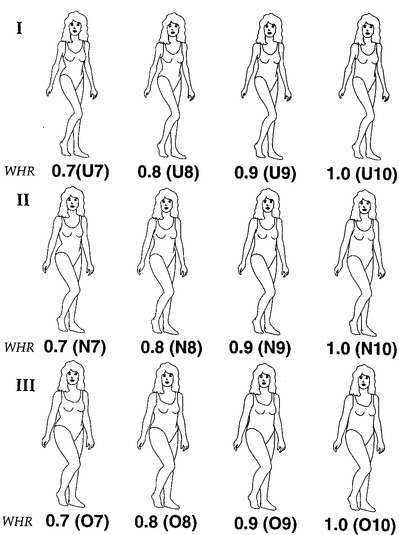
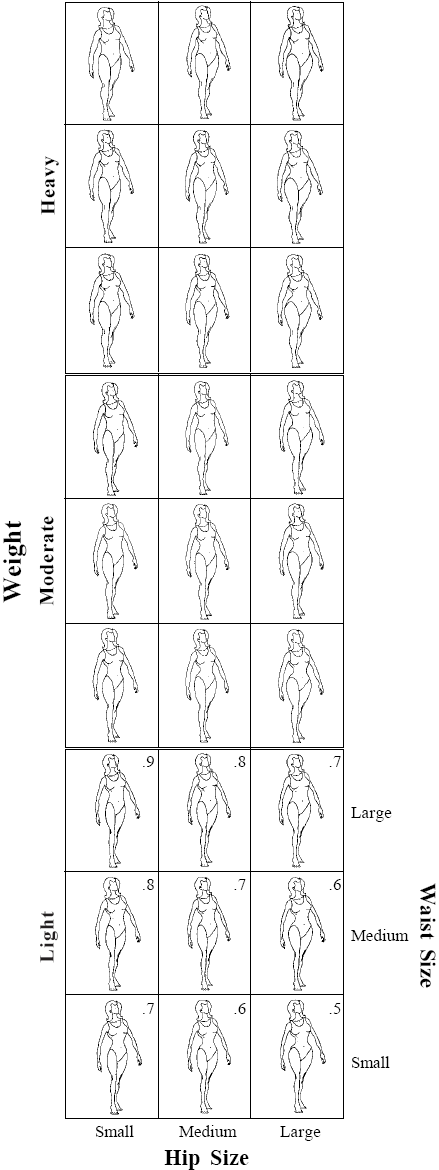
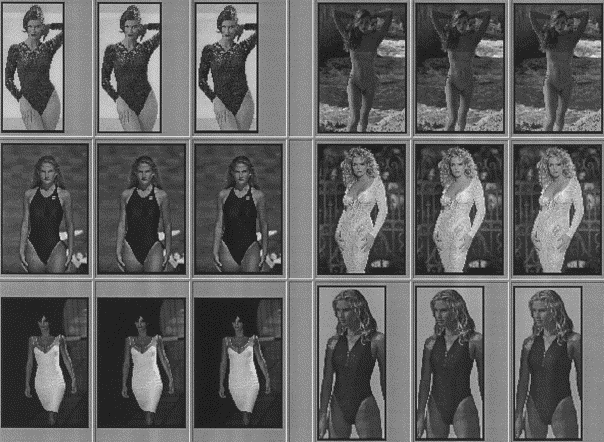
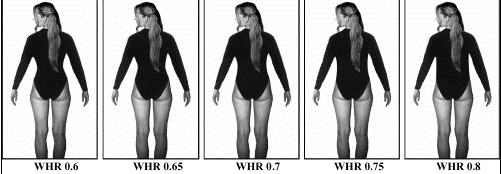
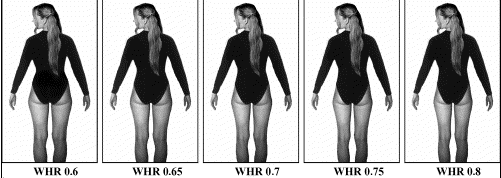



















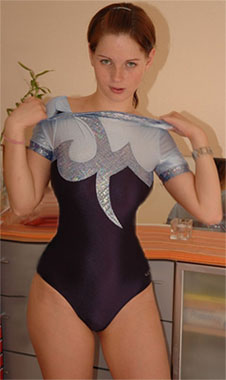
Comments
My hip:waist percentage is 6.8%, but my hip:bust percentage is about 9%.
what figure does this qualify me as?
This is a rectangle. And any shape is beautiful. Women are all different shapes and sizes and they are all beautiful.
This is a rectangle. And any shape is beautiful. Women are all different shapes and sizes and they are all beautiful.
no this is a rectangle
As a heterosexual man who values what makes the female body different from that of a male, I find a waist-to-hip ratio of 0.6 a bit more attractive than one of 0.7. This because all other things like build and shape of calves, shoulders and thighs being equal it creates a more feminine appearance, with an even more curvy and swinging gait and a beautifully curvaceous impression in any position.
I don't know why people are taking this website so personally. I personally have a waist-to-hip ratio of 0.6. My measurements are 36-22-37.5 and I am 5'1". People may find this not proportionate or they might not be attracted to it at all. I personally love my body and I may not have a body of a supermodel from Europe, I do have one of a Latin model. My boyfriend is latin and he loves my body because he likes my curves. So everyone don't get upset by someone who's showing facts. Love your body no matter what your shape is. Someone WILL love you body and you don't need approval from a website.
Hi
i know this is a few years old but i just stumbled across it then, i hope you can still help (:
i'm 18, 5'7" [or 169cm] and my measurements are 38B-32-30-38 [bust, just under bust, waist, hips]. my middle isn't very toned and still have some stubborn childhood/teen fat that i can't seem to shift.
i was wondering if you could help me out but telling me which body shape/s i might be, and also and style suggestions? i wear alot of high waisted things with belts that clench my waist but i'm not sure if this look good
many thanks!
I can understand Waist-Hip Ratio standard for health reasons but it is not accurate in measuring women’s curvature attractiveness to men. Why do you measure around the buttocks? Aren’t hips and buttocks two different things? I think some sort of Vernier Caliper should be used to measure from side to side instead of including the butt. That way you get a true and consistent hip size instead of all these different sized women with the same WHR. You can’t see hips from the side like you can the butt. Sophia Loren has hips; Kenya Moore has a big butt. Racquel Welch as hips; Buffy the Body has a big butt; Tyra Banks (now that she filled out) has hips; Bo Derek, with her narrow hips and flat butt, has a small curvature because of her even smaller waist. Anna Nicole with the same WHR as Kate Moss…give me a break!!! Kate looks like a man next to Anna.
The point is that though WHR is more accurate than the BMI, WHR indicates that more people need to lose body fat than the BMI does.
Okay, personally I love Christina Hendricks' look because she looks healthy, and she's not a stick. The whole stick thin thing is kind of gross in my opinion... I am 5'4", 151 pounds, and my measurements are bust: 36C, waist: 28" and hips 40". What shape do I have? I want a perfect hourglass like Ms. Hendricks or Ms. Monroe, but I'm not sure I have it...
My measurements are 30B-25-32...I look like an hourglass from behind, but a bit different from the front. Weird lol...But I was told I'm a ruler/banana shape.
Forget about being an hourglass, it is an impossible dream of European men from the 1950s. I f you are active and a modern intelligent woman, you shouldn't be bothered about all this crap.
The Hendricks and Monroe are cheaters: they squeeze themselves in waist reducing clothing and pretend to be perfect for the camera. Please don't fall for it...
Erik my measures are 42 32 42 do u knw wat I am or who I look like I'm also 5ft 9
Meg: At 42-32-42, yours is an hourglass figure according to clothing standards, but how feminine this appears in real life is a separate question. If you were short, these measurements would describe a thickset figure, but at 5-9, it depends. These measurement could be describing a voluptuous woman if the cup size is large or very large and the hips are well-rounded, or the physique could be muscular, with a large rib-cage/small breasts, and the appearance not so feminine. You know best.
I'm not too sure if I'll get many responses since the last comment was made back in 2007 but I just wanted to make a comment which I thought was valid.
Since women carry inches differently around the hip area, people need to see the woman in person rather than just base femininity on their numbers. According to the Hip to Waist Ratio I barely make the hour glass figure yet I look more feminine than my friends who have a larger hip to waist ratio. Even my boyfriend says that he prefers my shape to my friends since I have the classic hour glass feminine figure. The difference between my friends and I is that I'm extremely athletic with very wide hips bones but a tight perky small butt. Whereas my friends who have a larger difference between their hip size to their waist size aren't as fit and have smaller hip bones with big protruding bums.
I think that the hip to waist ratio is a good indication to see if you're healthy but can't really tell whether your figure is feminine or not.
My female friends have always been commenting on my wide hips but small perky butt even though my hip to waist is .74 and my friends are more like .69 or .7. Even the guys who know our circle of friends think that I have a classic hour glass figure. But that doesn't mean that my figure is the most desired by all men since men are all different and some like big bubble butts not an athletic tight butt. I do wish sometimes I had a bigger butt though:)
Just for reference my height is 5'9, chest 37, waist 28, hips 38. I'm medium to large framed.
This article is fascinating! I didn't realize how much there is to know about WHR. Of course, it makes me conscious of my own body. I don't know if this is the place for me to discuss myself, but I don't have a real-life outlet to receive feedback about issues concerning physical attractiveness.
My figure is 85-60-90. I believe 34-23.5-35.5 in inches. WHR of .666, so it sounds good in numbers. Yet I do not appear to have the coveted hourglass figure from a frotal view. My measurements suggest it, but I actually look boyish when seen from the front (or at least I think so). Yet I believe one would think I'm an hourglass by the numbers alone because from a side view my mid back dips in a lot, making a small waist, and my buttocks stick out a lot, making large hips. My front view is unimpressive though.
So femininity can't seem to be judged by WHR alone... And I am wondering if this makes sense, or if I am just misinterpreting what goes into having an hourglass figure.
The examples with the pictures:I think that its underestamated what clothes or in this case lingery can do to a body. If you look closely you will see that the lingery models are wairing lingery that is mostly marketet towards older women or women that are bigger in size i see some plusmodels in there also that indicates that its marketed towards bigger sizes. This type of lingery are hiding there curves. The lingery models are also older they look around the age of late 30's. The glamour models look around 18 years.
27 inch waist may be because of excess body fat? Are you nuts? Most women would love to have such a small waist. This person is hourglass if based completely on proportions. Of course, having a bit of excess in the lower body can happen, even with hourglass types. It depends on appearance as well as whether someone is overweight, underweight, or even just carrying a bit of extra. Also, this site in general is BS. A 2 inch difference between bust and hips is pretty close. It doesn't make someone a pear. What makes someone a pear is whether they gain all their weight in their thighs and hips, but none up top, as well as having a narrow ribcage and hips that are wider than the shoulders. Pears also have a defined waist. This body type is more common than the other types because women bear children and therefore carry extra in their lower half. Hourglasses are uncommon. The shoulders are aligned with the hips, and the bust is close to the same size as the hips but keep in mind, women with estrogen dominated body types (hourglass and pear) will gain saddlebags if they put on extra weight. Hourglass types gain elsewhere too, so tend to look more balanced, but the thighs and hips will likely still gain more than the upper body. So you can't base body type on just proportions unless you're at the ideal tone. The definition of rectangle is silly on this site. A waist ratio of less than 9 inches is extremely common but doesn't look rectangular at all, unless on a proportionally larger woman. Would a petite 5'3" 110 lb woman with 8 inches between her bust and hips be rectangular? Doubtful. More like hourglass or pear. Maybe body shapes aren't as important as we think
All this research for what ? Fewer that 8% of women today have hourglass figures! Most women have average figures. So what? These less than perfect women have men fall madly in love with them. They marry, have healthy children and live fulfilling lives as feminine, attractive women. Let's talk about Halle Berry. Everyone recognizes her perfect figure and perfect face. Sadly, her beauty has yet to hold a man for more than 5 minutes. What is the real point of obsessively trying to categorize women's waistlines? The WHR depends a lot on the size of a woman's rib cage and the span of her hips,. There is littlethatmcan be done to change these proportions. To say that a woman is not feminine because her WHR is off by a bit is ludicrous. There are plenty of celebrities, Cameron Diaz, Angelina Jolie, Demi Moore , Giselle Bundchen, Naomi Campbell and others, who are widely acknowledged as beautiful and who do not have hourglass figures. Even the current "It" girl Kate Upton is not an hourglass.
@April
"I think that the hip to waist ratio is a good indication to see if you're healthy..."
Perhaps, but there are a lot of good looking female athletes who would beg to differ. I think the whole WHR thing is a lot of BS designed to make women feel less than, or in the case of a butterface with a perfect WHR, more than the sum of their parts.
Pages